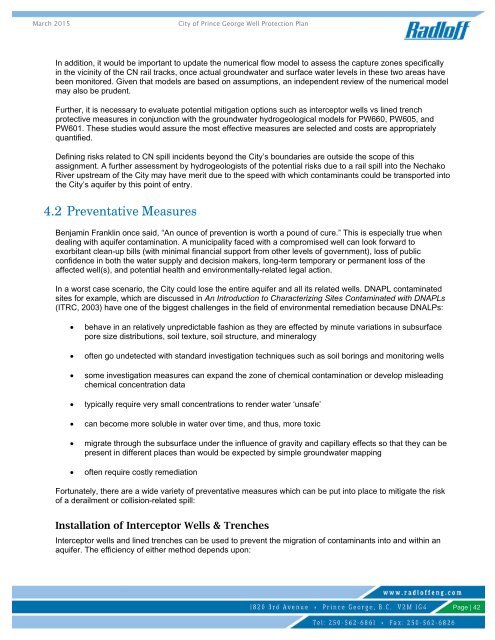CITY OF PRINCE GEORGE WELLS PROTECTION PLAN
Attch_February%2026%202016%20CPG%20wells%20protection%20report%20FINAL%20DRAFT%20V3
Attch_February%2026%202016%20CPG%20wells%20protection%20report%20FINAL%20DRAFT%20V3
You also want an ePaper? Increase the reach of your titles
YUMPU automatically turns print PDFs into web optimized ePapers that Google loves.
March 2015<br />
City of Prince George Well Protection Plan<br />
In addition, it would be important to update the numerical flow model to assess the capture zones specifically<br />
in the vicinity of the CN rail tracks, once actual groundwater and surface water levels in these two areas have<br />
been monitored. Given that models are based on assumptions, an independent review of the numerical model<br />
may also be prudent.<br />
Further, it is necessary to evaluate potential mitigation options such as interceptor wells vs lined trench<br />
protective measures in conjunction with the groundwater hydrogeological models for PW660, PW605, and<br />
PW601. These studies would assure the most effective measures are selected and costs are appropriately<br />
quantified.<br />
Defining risks related to CN spill incidents beyond the City’s boundaries are outside the scope of this<br />
assignment. A further assessment by hydrogeologists of the potential risks due to a rail spill into the Nechako<br />
River upstream of the City may have merit due to the speed with which contaminants could be transported into<br />
the City’s aquifer by this point of entry.<br />
4.2 Preventative Measures<br />
Benjamin Franklin once said, “An ounce of prevention is worth a pound of cure.” This is especially true when<br />
dealing with aquifer contamination. A municipality faced with a compromised well can look forward to<br />
exorbitant clean-up bills (with minimal financial support from other levels of government), loss of public<br />
confidence in both the water supply and decision makers, long-term temporary or permanent loss of the<br />
affected well(s), and potential health and environmentally-related legal action.<br />
In a worst case scenario, the City could lose the entire aquifer and all its related wells. DNAPL contaminated<br />
sites for example, which are discussed in An Introduction to Characterizing Sites Contaminated with DNAPLs<br />
(ITRC, 2003) have one of the biggest challenges in the field of environmental remediation because DNALPs:<br />
<br />
<br />
<br />
<br />
<br />
<br />
<br />
behave in an relatively unpredictable fashion as they are effected by minute variations in subsurface<br />
pore size distributions, soil texture, soil structure, and mineralogy<br />
often go undetected with standard investigation techniques such as soil borings and monitoring wells<br />
some investigation measures can expand the zone of chemical contamination or develop misleading<br />
chemical concentration data<br />
typically require very small concentrations to render water ‘unsafe’<br />
can become more soluble in water over time, and thus, more toxic<br />
migrate through the subsurface under the influence of gravity and capillary effects so that they can be<br />
present in different places than would be expected by simple groundwater mapping<br />
often require costly remediation<br />
Fortunately, there are a wide variety of preventative measures which can be put into place to mitigate the risk<br />
of a derailment or collision-related spill:<br />
Installation of Interceptor Wells & Trenches<br />
Interceptor wells and lined trenches can be used to prevent the migration of contaminants into and within an<br />
aquifer. The efficiency of either method depends upon:<br />
Page | 42


